Soil/Landform Unit 124
Landform Unit Description
Page top
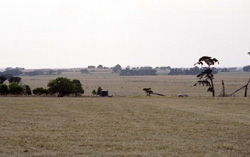 The undulating rises comprise scoria deposits near the most southern point of Lake Corangamite near Nalangil |
0.03% of CMA region This unit consists of undulating rises near Nalangil at the southern most extent of the current Lake Corangamite shore. This small single unit is derived from ash, scoria and basaltic lava deposits and forms part unit of the volcanic Western Plains. This soil landform of the Western Plains is characterised by undulating low stony rises with prominent plains and minor depressions. Remnant vegetation classes of these undulating rises includes Swamp Scrub and Scoria Cone Woodland. These plains and low rises have black gradational soils with minor occurrences of brown gradational soils and shallow friable loams, especially in combination with surface stones on crests and upper slopes of rises. The depressions also comprise the black gradational soils of the plains and rises. The ash and scoria deposits are generally friable and highly productive due to high fertility. Land use is mainly dairy farming, grazing and minor cropping. The shallow soils tend to be susceptible to waterlogging (in wet seasons) and compaction. | 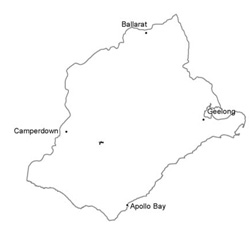 |
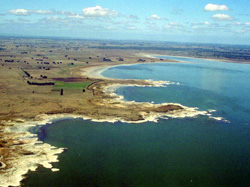 Looking south towards Pirron Yallock over the undulating rises bordering Lake Corangamite |  |
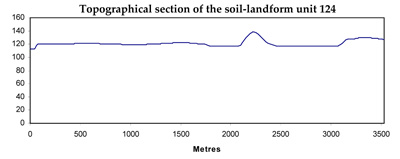 | 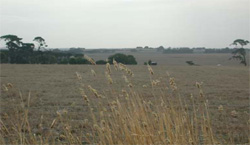 Looking south towards the undulating rises that are mainly used for grazing and diary near Nalangil |
Component | 1 | 2 | 3 |
Proportion of soil-landform unit | 15% | 80% | 5% |
| CLIMATE Rainfall (mm) | Annual: 750 | ||
| Temperature (oC) | Minimum 8, Maximum 19 | ||
| Precipitation less than potential evapotranspiration | November-March | ||
| GEOLOGY Age and lithology | Quaternary scoria and minor basalt, Recent clay, sand and gravel | ||
| Geomorphology | |||
| LANDUSE | Uncleared areas: Nature conservation; water supply Cleared areas: Dairy farming; sheep and cattle grazing; cropping | ||
| TOPOGRAPHY Landscape | Undulating rises | ||
| Elevation range (m) | 113-129 | ||
| Local relief (m) | 25 | ||
| Drainage pattern | Centripetal - radial | ||
| Drainage density (km/km2) | 1.3 | ||
| Landform | Plains and minor low rises | ||
| Landform element | Low rises | Undulating plains | Drainage depressions |
| Slope and range (%) | 3 (1-7) | 1 (0-3) | 1 (0-2) |
| Slope shape | Convex | Linear | Concave |
| NATIVE VEGETATION Ecological Vegetation Class | Swamp scrube (8.1%), Scoria Cone Woodland (5.9%) | ||
| SOIL Parent material | In situ basalt | Basaltic ash and colluvium | Basaltic ash and colluvium |
| Description (Corangamite Soil Group) | |||
| Soil type sites | |||
| Surface texture | Clay loam to loam | Clay loam | Clay loam |
| Permeability | Moderate to high | Moderate | Low to moderate |
| Depth (m) | <1.5 | <1.5 | <2 |
| LAND CHARACTERISTICS, POTENTIAL AND LIMITATIONS | Friable structured soil. Soil depth may be shallow to moderately deep with limited water holding capacity. Well drained and high nutrient holding capacity. Upper soil may be acidic. | Friable structured soil. Soil depth may be moderately deep with limited water holding capacity. Generally well drained and high nutrient holding capacity. Upper soil may be acidic. | Friable structured soil. Soil depth may be moderately deep with limited water holding capacity. Moderately well to imperfectly drained and high nutrient holding capacity. Upper soil may be acidic. Subject to waterlogging and compaction. |


